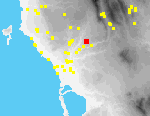 B02
Hora Kavalaria
B02
Hora Kavalaria
At the center of Site B2 is the church of Ayios Nikolaos, located at Kavalaria, a flat-topped rise,[113.19] some 600 m. S of the outskirts of the modern town of Hora.[095.13] It is clear from Venetian and Ottoman censuses that there was a village at Kavalaria in the 17th and 18th centuries. The large size of the church and its elaborate architectural decoration suggest that it was the principal ecclesiastical focus of the community.
Artifacts are concentrated around the church and to the E and S of it, on bulldozed terraces and natural slopes that descend into the valley that separates Sites B2 and B1. Almost the entire site is covered by olives; many of those N of the church are extremely old. A few small fieldhouses are associated with small vegetable gardens. The churchyard is itself very weedy and overgrown.
The church is similar in plan to many in western Messenia, wide and single-aisled with three projecting polygonal apses. Today it has a single arched entrance at its west end;[113.09] incised in a cut block immured over the present arched western entrance are the dates, 1709 and 1948.[095.07] Resting against the western facade of the church are 15 worked blocks that are likely to have once been parts of the church. Left of the church door is a shelly limestone block with a basin-like depression (0.10 x 0.25 x 0.05-0.07 deep) on top.
In the S wall of the church near the apse an arched opening[095.11] has been partly walled up, but the interior of the church is still visible through it. The wider central apse has a slit window, framed with limestone blocks. In the N wall, an arched doorway surrounded by decorative brickwork and by cut limestone blocks[095.05] with incised grooves, has been completely walled up with brick and tile.
In addition to these alterations, there is evidence in the walls of the church itself for at least two periods of construction. The E wall, its apses, and the lower parts of the N and S walls appear to be remains of the first church built here (?in 1709). The upper parts of the N and S walls belong to a second phase of construction (?in 1948). The entire W wall seems also to have been constructed in the second phase; no part of it is bonded to the remains of the original N and S walls.
Ca. 20 m. W of the church entrance, projecting ca. 0.4 m. from the earth, is a conglomerate column-shaped stone (0.6 m. W.) with a deep round hole on top.[113.15]
Byzantine pottery was principally noted in the areas adjacent to the church. Turkish-Early Modern pottery was found in all parts of the site.
Ceramic material collected from this site was divided primarily into two discrete chronological groups, as noted above in the site description. Byzantine pottery includes well-made table wares, cooking wares and coarse ware storage vessels. Turkish-Early Modern pottery likewise included fine tablewares and coarser storage vessels.